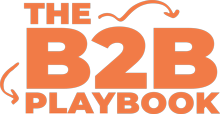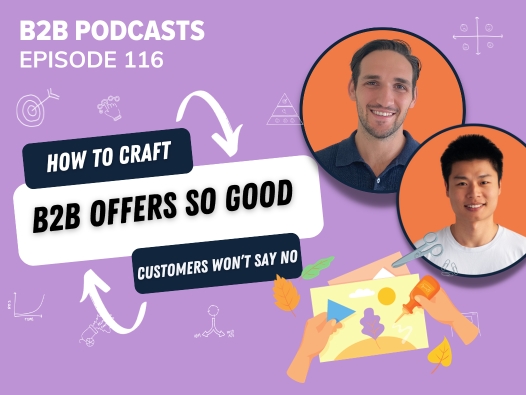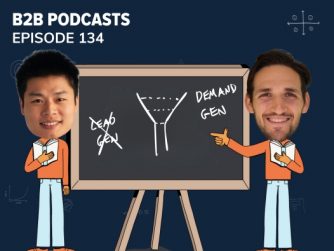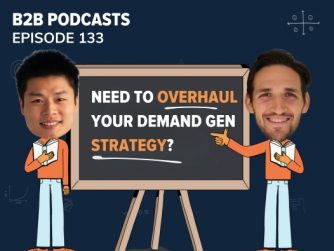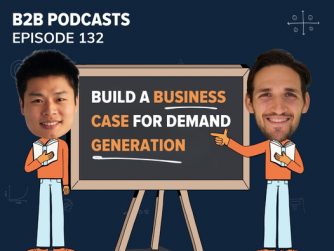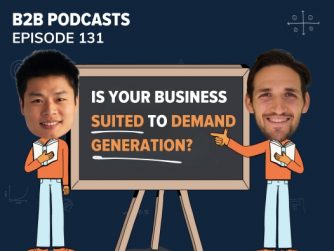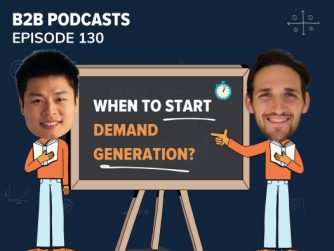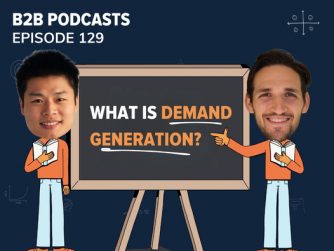Make an offer SO DAMN GOOD that your customer feels stupid saying ‘NO’ to it.
That’s the challenge we laid down to our B2B marketers in this episode of The B2B Playbook. Now, most marketers when they think about an ‘irresistible offer’ turn their minds to pricing, free trials, or overpromising with huge commercial outcomes.
But that’s not a sustainable approach. And here at The B2B Playbook, we’re all about long term b2b demand generation strategies that scale.
An ‘irresistible’ offer is about creating an offer so perfectly aligned with your customers’ deepest needs that they would find it irrational to decline. So today, through our easy to follow seven-step process, we’ll show you how you can transform your offer from ‘just another option’ to the obvious choice for your Dream Customer.
Listen To The Episode
Watch The Episode
Step 1. Niching Down: Be a Big Fish in a Small Pond
The first step to crafting an offer SO damn good that your customer feels stupid saying ‘NO’ to it, is niching down.
Niching down means identifying a segment of the market, and updating your positioning and messaging to focus on serving that segment better than anyone else. It’s what makes you the big fish in the small pond, and is a fantastic way of cutting cut through in a noisy world.
“Once you niche down, you can then really understand your dream customers a lot better”
George Coudounaris – The B2B Playbook [00:11:00]
This deeper understanding allows you to tailor your offer to their specific needs, requirements, and pain points. It’s about creating an offer that is not just visible but essential for your target audience.
Also, it’s way easier to communicate the value of your product or service when you niche down. As you become more specialized, “if the market is large enough…you can start to charge more for it because your features can be tailored to them” [00:06:10]. This approach ensures that the benefits you offer are highly relevant and valuable to your specific audience.
For example, consider a time management software tailored for outbound B2B sales reps in the power tools and gardening sector. By focusing narrowly, you position this product as the only viable solution for this audience. This allows you to justify a higher price point because “you’re really the only alternative for these particular groups of people for that particular niche” [00:04:50].
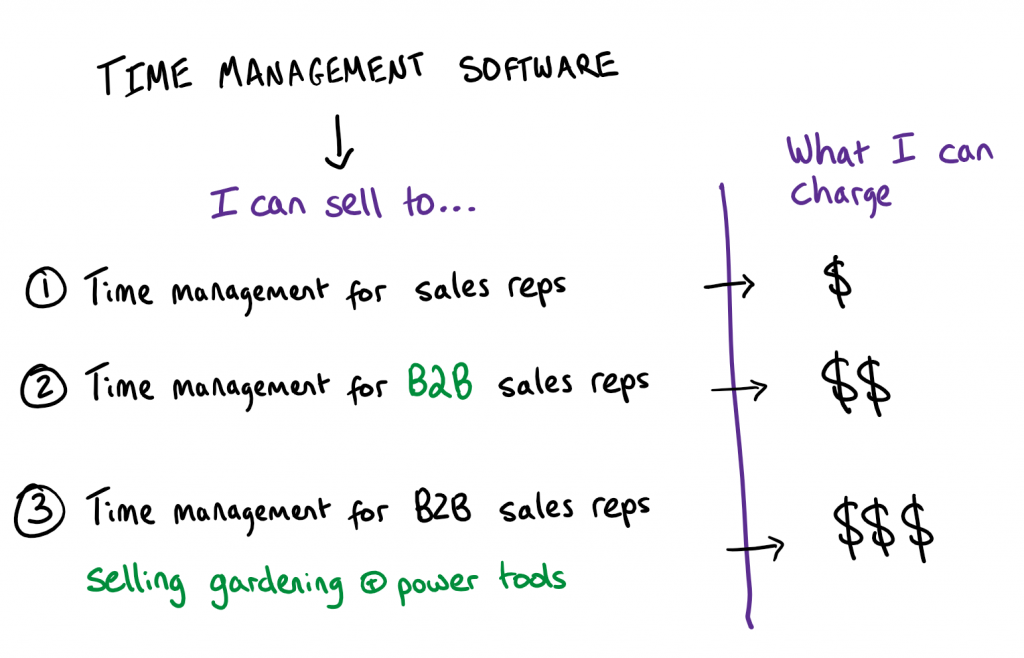
Niching down involves more than just making promises about outcomes. It’s about a commitment to understand and reduce the effort required by the buyer to achieve these outcomes. “Reducing the time to success and reducing the effort to achieve this becomes really crucial,” and is more effective once you’ve niched down, as “we know exactly what their problems are and we know exactly how to remedy it” [00:10:50].
Your focus on their problems means that you can deliver more value. The more value you deliver, the more money you can charge for your product.
Don’t get lost in the noise of the competition. Be the big fish in the small pond. Make sure you niche down!
Step 2. Understanding Your Dream Customers
After you’ve successfully niched down, the next crucial step is to truly understand your dream customers. This process involves getting specific about their needs, their requirements, and their biggest pain points [00:11:10].
Understanding your dream customers is about putting yourself in their shoes.
“Put yourself in the shoes of your dream customers and ask yourself (or ask them): what would the dream outcome be for those customers if they used your solution to their problem?”
George Coudounaris – The B2B Playbook – [00:09:20]
This approach is key to identifying what truly matters to them and ensuring that your offer aligns with these outcomes.
In the process of becoming more specific and niche, you can tailor your features to meet the unique needs of your dream customers. “As you become more specific, as you become more niche…your features can be tailored to them” [00:06:20]. This tailoring amplifies the benefits they receive from your product, which in turn enhances the value they perceive in your offering.
This is a crucial step in our 5 BEs Framework. It’s all about deeply understanding the customer, and aligning your offer as a way to solve their pain.
Step 3. Defining Your Unique Value Propositions: Articulating What Sets You Apart
The third critical step in crafting an irresistible B2B offer is defining your unique value propositions (UVPs). This step is about distilling what makes your product uniquely beneficial to your dream customers.
Once you have a deep understanding of your dream customers, the next task is to put that knowledge into action.
“After you have that understanding of your dream customers, let’s start putting that into action. Step three is defining your unique value propositions based on this dream outcome you have established in understanding your dream customers”.
George Coudounaris – The B2B Playbook – [00:11:50]
This involves using the insights from customer interviews to map out their pain points and aligning your product’s features and benefits to address these pain points effectively.
The process of defining UVPs (unique value propositions) goes beyond merely listing features and benefits; it’s about understanding why your company serves a particular segment of customers better than anyone else in the market.
“We need to go one level further… List out your top 10 features and benefits of your product in the eyes of the customer” [00:12:10]. This deep dive helps you identify the aspects of your product that truly resonate with your target audience.
A well-articulated UVP makes it obvious to the customer why your product is the perfect fit for them. “That’s where your unique value proposition is. And the more readily identifiable your unique value is to a customer, the more they’re going to be like, oh of course you guys are perfect for me because you serve me in a way that nobody else does” [00:13:40]. This clarity in communication makes sure that your target audience immediately recognizes the unique benefits your product offers, making your value proposition not just understood but felt.
In essence, defining your UVPs is about showcasing how your product or service uniquely solves the problems or fulfils the needs of your target customers. It’s a super important step in making your offer not just attractive but irresistible, as it clearly demonstrates the specific advantages your customers will gain by choosing your product over others.
Step 4. Positioning Your Company: Choosing the Right Battle in the Market
Positioning your company is the fourth crucial step in creating an irresistible B2B offer. We go deep into positioning in this episode.
“Step four is now we take all that information and we’re going to position our company”
The B2B Playbook – [00:16:00]
This involves deciding how you want your company to be perceived in the market relative to your competitors and based on your unique value propositions.
We discussed the three primary types of positioning strategies:
- Head-to-Head Positioning: This strategy involves challenging the market leaders directly by convincing customers that your solution is superior. It’s about entering a well-defined market and trying to take on established leaders by positioning your product similarly to theirs. For instance, entering the CRM market and attempting to compete with giants like Salesforce or HubSpot is an example of head-to-head positioning [00:16:20].
- Big Fish, Small Pond Positioning: This positioning strategy is about dominating a specific segment of the market rather than challenging the overall market leaders. It involves identifying a sub-segment with slightly different requirements that aren’t being met by the current market leader. This approach is akin to carving out a niche for yourself within an existing market [00:17:20].
- New Category Positioning: The most ambitious of the three, this strategy involves creating an entirely new market category. It requires businesses to first prove that a new market category deserves to exist, then define the parameters of that market, and ultimately position themselves as the leader within this new category [00:18:40].
Each of these positioning strategies requires careful consideration of your company’s strengths, your target market, and the competitive landscape. The choice of positioning will significantly impact how your product or service is perceived and can be the deciding factor in how well it resonates with your target audience.
In general, our recommendation is to take the “Big Fish, Small Pond” positioning strategy as it can be executed with fewer resources in a shorter amount of time. It’s also normally easier to align your positioning with a niche, so you can serve their interests better than anyone else – making your offer truly irresistible.
Step 5. Determining Your Price Strategy: Balancing Value and Perception
The fifth step in crafting an irresistible B2B offer is determining your price strategy [00:24:50]. This step is crucial as it balances the perceived value of your product or service with the economic realities of your target market.
A well-thought-out pricing strategy is really important for several reasons. Firstly, you can justify a higher price point when you’ve niched down.
As we discussed, “when you niche down at the beginning of step one…you are able to drive up that price”
The B2B Playbook – [00:26:30]
This is because a more targeted approach often leads to a better product-market fit, allowing you to charge more due to the increased value you offer to a specific segment.
Moreover, a value-based pricing strategy makes it easier to articulate and defend your pricing to the buying committee. “Value-based pricing means it’s much easier to make your business case” [00:26:50]. By focusing on the return on investment (ROI) and the value your product or service provides, you can create a compelling narrative that resonates with your customers’ business needs.
It’s also important to consider how your pricing aligns with the outcomes your customers desire. As stated, “whatever pricing strategy you choose, it should really be based on just that, on that value that you are driving” [00:26:10]. For example, if you can demonstrate that your product or service offers a 10x return for your customer’s business, this can make your price seem not only reasonable but also highly attractive [00:25:50].
In essence, determining your price strategy is about finding the sweet spot where your customers perceive your offer as valuable and are willing to pay the price that you’ve set. It’s not just about covering your costs or achieving a high-profit margin; it’s about aligning your price with the value you deliver, thereby making your offer irresistible in the eyes of your customers.
Step 6. Reducing Customer Fear: Building Trust and Confidence in Your Offer
The sixth step in creating an irresistible offer is reducing the fear in the mind of your customers [00:28:30]. This step is so important!
You have to address any apprehensions or risks perceived by potential buyers. It’s your job to make them feel secure and confident in their decision to choose your product or service.
To effectively reduce customer fear, it’s essential to understand the human element involved in the buying process. As mentioned in the podcast, “remember that it is a human on the other side of this” [00:28:36]. Recognizing the emotional and professional stakes for your customer in making the right decision is key to building a reassuring and trustworthy offer. If a recommendation for your product or service doesn’t work out, it reflects poorly on the individual who advocated for it, affecting their credibility within their organization [00:28:40].
One effective way to mitigate these fears is through social proof and guarantees.
“You would try and sell to other sales led organizations using their case studies because they’re things that are very relatable” [00:30:10]. Demonstrating success stories from similar companies provides tangible evidence of your product’s effectiveness and reliability [00:30:20].
Finally, reducing the time and effort required to achieve the desired outcomes is another key factor. “Reducing the time to success and reducing the effort to achieve this becomes really crucial” [00:10:40]. By demonstrating how your product simplifies processes and accelerates results, you can significantly alleviate the customer’s fears and concerns [00:10:50].
Step 7. Crafting and Testing Your Offer: Refining the Perfect Proposition
The seventh and final step in creating a compelling B2B offer is the process of crafting and testing your offer [00:30:30]. This crucial stage involves fine-tuning your proposition to ensure it resonates strongly with your target market.
Here’s how to do it:
Identifying the Key Components of Your Offer
It’s essential to define clearly who your offer is for, the value it provides, and the timeframe for delivering that value. As we highlighted in the podcast episode, “Who is that offer for? What’s the value? Can you put a number on it? And what’s the timeframe for delivery of that value?” This clarity helps in crafting an offer that is both specific and compelling [00:31:00].
Validating Your Offer with Your Best Customers
Before launching your offer to the broader market, it’s crucial to validate it with your best customers. “Make sure that you validate that with your best customers before you take it to market. It’s gonna save you a lot of time and a lot of money in testing” [00:33:20]. This validation step ensures that your offer is not only theoretically sound but also practically effective.
Testing Different Elements of the Offer
Testing different framings and elements of the offer with your target audience is vital. “Combine all these to test different offers, different framings of these different elements, and send it to your best customers as well” [00:31:20]. This process allows you to understand what resonates most with your dream customers and what elements of your offer are most appealing.
Real-world Example of Testing an Offer
In one real-world example, we demonstrated this process by testing different offers with one of our customers, Monica (in a well documented collaboration). “We sent combinations of these out to our best customers to see which resonate the most… And it’s the one that’s sitting on our landing page right now” [00:32:50]. This direct feedback from customers is invaluable in refining and finalizing an offer that genuinely connects with your audience.
Crafting and testing your offer is about more than just creating a value proposition; it’s about iteratively refining it based on direct feedback from your target market. By carefully testing and validating each element of your offer, you ensure that it is perfectly tailored to meet the needs and expectations of your dream customers, making it an irresistible choice for them.
Wrapping It All Up: Crafting an Irresistible B2B Offer – A Comprehensive Approach
Okay – you should now understand how to create your own irresistible B2B offer. As you can see, it’s a bit of a strategic blend of understanding, precision and creativity. Each of the seven steps plays a critical role in sculpting an offer that not only meets but exceeds the expectations of your dream customers.
A quick highlight reel again of each of the 7 steps for crafting your offer are:
- Niching Down: This is the foundational step where you identify and focus on a specific market segment. By zeroing in on a niche, you can create an offer that resonates deeply and personally with a targeted group of customers, enhancing its relevance and appeal.
- Understanding Your Dream Customers: This involves a deep dive into the psyche, needs, and pain points of your target audience. Through this understanding, you can craft an offer that precisely addresses their specific challenges and aspirations, making it more likely for them to engage with your product or service.
- Defining Your Unique Value Propositions: Here, you articulate what sets your product apart. This step is about highlighting the unique features and benefits that make your offer stand out in the market. It’s about ensuring that your product or service is not just another option but the best solution for your customers.
- Positioning Your Company: Choosing the right positioning strategy is crucial. Whether it’s head-to-head, big fish in a small pond, or creating a new category, your positioning determines how your offer is perceived in the marketplace and can be the key to unlocking its full potential.
- Determining Your Price Strategy: This step is about setting a price that reflects the value your offer brings to the customer. A well-thought-out pricing strategy not only covers your costs but also communicates the worth of your product or service, making it a no-brainer for the customer to invest in.
- Reducing Customer Fear: To make your offer truly irresistible, it’s essential to address and alleviate any fears or apprehensions your customers might have. This involves using strategies like social proof and guarantees to build trust and confidence in your product or service.
- Crafting and Testing Your Offer: The final step involves fine-tuning your offer based on feedback from your target market. By testing different aspects of your offer and validating them with your best customers, you ensure that it not only meets but exceeds their expectations, making it irresistibly appealing.
Each step, from understanding your niche to validating and testing your offer, plays an important role in creating a proposition that not only captures attention but also wins hearts and minds. It’s about putting your best customers at the heart of what you do. By following these steps, you can transform your offer from just another product or service into a solution that your customers feel compelled to choose.
Create Your Demand Engine in 12 Weeks
B2B marketing strategy that shows you step-by-step how to drive revenue
